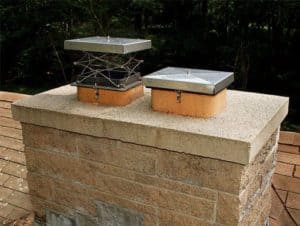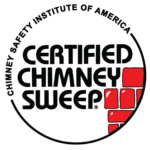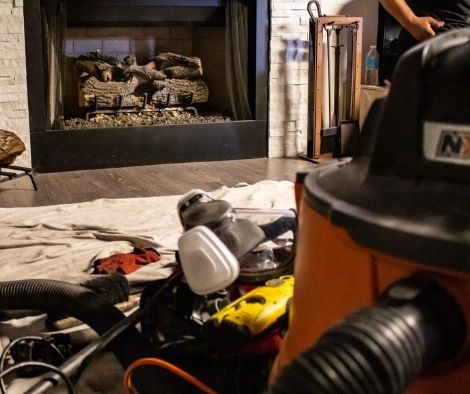Have you ever lit a fire in your fireplace only to have it start smoking shortly thereafter? If so, you’re not alone. This is a common problem that many homeowners face when using their fireplaces. In this blog post, we’ll explain some of the most common reasons why fireplaces start smoking after lighting them. We’ll also provide some tips on how to avoid this problem in the future. Smoke coming from your fireplace is not only an inconvenience, but it can also be dangerous. Smoke inhalation and contact with fire can cause serious health problems, damage to your home, and even death.
Fireplaces can add so much warmth, ambiance, and aesthetics to your home, but it is important to be aware of any safety concerns that may arise. If you notice smoke coming from your fireplace, you should take action immediately to ensure your safety and the safety of those around you.
There are five primary reasons why your fireplace is smoking:
- Creosote
- A Cold chimney
- Downdrafts
- Poor Ventilation
- Incorrect Flue Size
Let’s take a closer look at each one.
Creosote: A Big Fireplace Smoking Problem
One of the most common causes is a buildup of soot or creosote on the inside of the chimney. Creosote is a highly flammable material that builds up on the walls of your chimney. It’s a byproduct of burning wood and can accumulate quickly, especially if you are burning wet wood. If there’s creosote on the walls of your chimney, it can cause your fireplace to smoke due to the flammable nature of creosote.
Are you familiar with Rachel Ray, the famous TV chef? If so, you may be surprised to learn that she had her home badly damaged by a chimney fire. The fire was caused by a buildup of creosote on the walls of her chimney. This just goes to show that whether you do or don’t use your fireplace often, it’s still important to have it cleaned regularly to prevent a creosote buildup. Camera Inspections will be able to see if creosote is present in your chimney. If any creosote is discovered, at minimum a chimney sweep should be done by a Certified Chimney Service, such as ours at Masters Services.
A Cold Chimney
One of the most common reasons why fireplaces smoke is because the chimney is too cold. When the temperature outside is cold, the air inside the chimney cools as well. This can cause the fireplace smoke to condense on the inside of the chimney flue and start smoking. The solution to this problem is simple: just wait for the chimney to warm up. Once the chimney warms up, the fireplace smoke should stop condensing and start rising up the chimney and out. Discussed later in this blog is why you should start small fires and build your way up to larger fires.
Downdrafts
Another common reason for fireplace smoking is downdrafts. Downdrafts occur when cold air enters the home through the fireplace and pushes the warm air up the chimney. This can cause a build-up of pressure in the chimney which, in turn, can cause the fireplace smoke to be pushed back into the room. The best way to combat this problem is to make sure that your fireplace is properly ventilated. This way, the cold air will be able to escape and the downdrafts will be less likely to occur.
Poor Ventilation

The fourth reason why fireplaces smoke is poor ventilation. This can be caused by a number of things, like a faulty damper, a blockage in the flue, a damaged flue liner or improper installation of the fireplace system. A broken or damaged damper can restrict the amount of air that flows through the chimney, which can cause the fire smoke to be pushed back into the room. It is always best to make sure your damper is in the open position before starting a fire.
Another ventilation-related problem is having an obstructed or blocked chimney. If there is an obstruction in the flue, it can be very dangerous as sticks, nests, and debris are combustible and can cause a chimney fire. If you suspect that poor ventilation is causing your fireplace to smoke, then you’ll need to have a professional inspect and repair your fireplace. They will be able to identify any problems and make sure that your fireplace is operating correctly.
Incorrect Flue Size
The final reason talked about in this blog of why your fireplace may be smoking is because the flue is the wrong size. The flue is the part of the chimney that goes from the fireplace to the outside of the home. If the flue is the incorrect size for the firebox, then it won’t be able to handle all of the smoke coming from the burning fireplace. This can cause the smoke to back up into the living space. The best way to avoid this problem is to make sure that the flue is the correct size for the firebox. A professional should be able to help determine if your flue is the correct size for your home’s firebox. If you have a fireplace that smokes, it’s important to take action to fix the problem.
How to Prevent Fireplace Smoking
Now that we have looked at some of the reasons why fireplaces smoke, let’s talk about how to prevent it. Sometimes the smallest factor can change the physics behind your fireplace like damper position, age of wood, amount of wood your adding, fireplace grates, placement of wood, and annual inspections and sweeps. Let’s go into further detail about how we can prevent smoke from coming into your home from a burning fire.
- Make sure your damper is open
- Use dry-seasoned wood
- Start with a small fire and work your way up
- Use a Fireplace Grate
- Place all firewood towards the back center of the firebox
- Get your chimney inspected and swept annually
Fireplace Damper in the Open Position
The first step in preventing fireplace smoke from entering your home is to make sure that your damper is open. The damper is a door that sits at the bottom of the chimney and opens when you light a fire, and is meant to be closed in the hotter months to prevent hot air from getting in your home. Opening the damper, allows air to flow into the chimney to help oxygenate the fire while allowing for heat and smoke to escape up and out of the chimney.
If the damper is closed, then the smoke can’t flow out and the smoke will be pushed back into the room. When a customer is in need of a new damper, we often install seal-tight dampers or energy top dampers.
Prevent Fireplace Smoking by using Dry-Seasoned Wood for your Fires
Another way to help prevent smoke from coming into your home is to use dry-seasoned wood. Seasoned wood is wood that has been cut and allowed to sit for six months to a year. This allows the excess moisture to evaporate, making for a more clean burn. The amount of moisture in dry seasoned wood should be between 15% to 25% moisture content. Moisture Meters are inexpensive to purchase to help prevent burning wet wood.
Start with a Small Fire and Work your Way Up
When you’re ready to start your fire, it’s important to start small and then build up in size. A small fire will slowly warm up the chimney and allow the smoke to rise up and out. Once the chimney is warmed up, you can add more wood, one by one, to the fire. Adding too much wood at once will cause the chimney to cool down and the smoke will be pushed back into the room and can potentially cause damage to parts of your chimney, like cracks in your fireplace panels or chimney liner. Cracks occur when too much heat is applied at one time and
Use a Fireplace Grate
A fireplace grate is a metal frame that sits in the firebox and holds the wood up a few inches. The spaces between the bars allow air to flow around the wood and help the fire to breathe. Place all firewood towards the back center of the firebox onto the grate. Without enough air feeding the fire, excess fireplace smoke can be caused. Did you know that depending on your firebox size and style that you should have a properly fitted grate? Grates are not one size fits all, and if you have the wrong size grate it can actually cause possible problems for your chimney.
Annual Maintenance: Chimney Inspections & Chimney Sweeps
One of the best ways to prevent fireplace smoke from entering your home is to have your chimney inspected and swept annually. A professional chimney sweep will clean out any buildup of creosote and soot, and check for any obstructions or damage. Having your chimney inspected and cleaned regularly will help to ensure that it’s operating correctly and that smoke can flow freely throughout the chimney.
When should you have your chimney inspected?
A qualified chimney expert should inspect your chimney and fireplace once a year, before lighting your fireplace at the start of the burning season, after any increase in concern following usage of the chimney, and prior to purchasing a house with a chimney.
How do I find a Certified Chimney Professional in my area?
Masters Services Chimney & Masonry serves the Dallas-Fort Worth Metroplex, Houston, and Oklahoma City residences. If you are in need of a Certified Chimney Professional in your area, we recommend going to CSIA organization to find your professional by typing in your zip code. The CSIA stands for the Chimney Safety Institute of America and to become a CSIA Certified professional, all chimney sweeps have to go through a rigorous certification process and pledge to uphold the highest standards in the chimney industry. You can also find more reasons why it is important to hire a certified chimney sweep by visiting our Masters Blog!
Conclusion

If your fireplace starts smoking, then you should always consult with a certified chimney professional. Masters Services has 25 years in the chimney industry and is home to 19 Certified Chimney Professionals. A professional will be able to diagnose the problem and make suggestions on what repairs or services should be done to make sure that your fireplace is operating as it is intended.
The most common causes of smoking in fireplaces are the presence of creosote, cold chimneys, downdrafts, and poor ventilation. Have a professional inspect and repair your fireplace if your chimney is smoking after it is lit. We hope this gave you some more information on the reasons your fireplace may be smoking. If you have further questions or want to schedule your camera inspection please contact our office for scheduling information. Thanks for reading!



